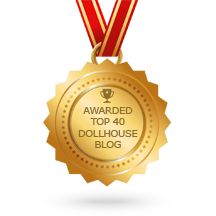As
a young girl my Mum showed me a book about the spectacular Faberge
eggs. The eggs themselves are beautiful. However, it was the
delightful miniatures inside the eggs that captivated me. I thought the
story behind the eggs, the mystery
surrounding the Imperial family, and the whereabouts of the eggs now,
all too be very romantic. Miniatures are more than dollhouses as we all
know. Think about the other art forms fascinated by the small!
A Fabergé egg is one of a limited number of jeweled eggs created by Peter Carl Fabergé and his company between 1885 and 1917. The most famous are those made for the Russian Tsars Alexander III and Nicholas II as Easter gifts for their wives and mothers, often called the 'Imperial' Fabergé eggs. The House of Fabergé made about 50 eggs, of which 43 have survived. Two more were planned for Easter 1918, but were not delivered, due to the Russian Revolution.
Enjoy! ~judy www.justminiaturescale.com
A Fabergé egg is one of a limited number of jeweled eggs created by Peter Carl Fabergé and his company between 1885 and 1917. The most famous are those made for the Russian Tsars Alexander III and Nicholas II as Easter gifts for their wives and mothers, often called the 'Imperial' Fabergé eggs. The House of Fabergé made about 50 eggs, of which 43 have survived. Two more were planned for Easter 1918, but were not delivered, due to the Russian Revolution.
Enjoy! ~judy www.justminiaturescale.com
The
Imperial Coronation Egg 1897: The egg was made to commemorate Tsaritsa,
Empress Alexandra Fyodorovna. The egg is made from gold with
translucent lime yellow enamel on a guilloché field of starbursts and is
in reference to the cloth-of-gold robe worn by the Tsarina at her
Coronation. Fitted inside a velvet-lined compartment is a precise
replica, less than four inches long, of the Eighteenth-century Imperial
coach that carried the Tsarina Alexandra to her coronation at Moscow's
Uspensky Cathedral.
Beautiful! ~judy www.justminiaturescale.com
Beautiful! ~judy www.justminiaturescale.com
The
First Hen Egg or Jeweled Hen Egg: The crafting of the first Imperial
egg is attributed to Erik Kollin of Fabergé's workshop. The egg is made
of gold completely coated with opaque white enamel to look like a real
egg shell. The two halves open to reveal a gold yolk with a matte
finish, containing a varicolored gold hen with ruby eyes. The hen is
hinged on the tail feathers which allows it to also
open up to reveal two additional surprises which are now missing. The
first of these was a gold and diamond replica of the imperial crown.
Suspended within the crown as the final surprise was a tiny ruby
pendant. A necklace chain was included so the Tsarina could wear the
pendant.
Oh do you not wonder what happened to the crown and necklace?? ~judy www.justminiaturescale.com
Oh do you not wonder what happened to the crown and necklace?? ~judy www.justminiaturescale.com
The
Basket of Wild Flowers egg: The egg is designed as a basket of wild
flowers, with the date of manufacture displayed in diamonds.
~judy www.justminiaturescale.com
~judy www.justminiaturescale.com
The Rosebud egg: The egg opens to reveal a yellow enameled, mechanical rosebud, in which the two surprises were originally contained. The surprises are missing, but they were a golden crown, with diamonds and rubies, and cabochon ruby pendant.
~judy www.justminiaturescale.com
The Bay tree egg (also known as the Orange tree egg): Turning a tiny lever disguised as a fruit, hidden among the leaves of the bay tree, activates the hinged circular top of the tree and a feathered songbird rises and flaps its wings, turns its head, opens its beak and sings!
~judy www.justminiaturescale.com







Hello Judy,
ReplyDeleteI have always thought that Faberge eggs are the most beautiful works of art. They are pieces I would want in real life. Great pictures!
Big hug,
Giac